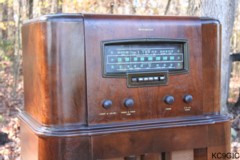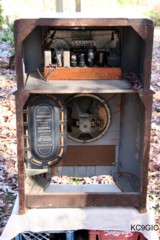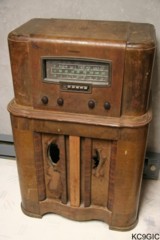
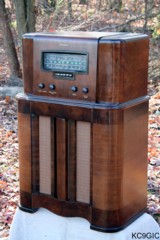
"Before" "After"
Brand: Westinghouse Electric
Corp. Year Of
Manufacture: 1940 Frequency Range(s): 550 - 1750KC, 1.4 - 4 MC, 6 - 18 MC
Tube
lineup: 5Y3G Rectifier, (2X) 6F6G PP Output, 6SF5 P.Inv., 6SF5
A.F., 6H6 2nd Det/AVC, 6SK7 I.F.,6SA7
1stDet/Osc, 6SK7 R.F.
Schematic: Available here, courtesy of Nostalgia Air. Riders 12-27
Schematic: Available here, courtesy of Nostalgia Air. Riders 12-27
I came home from a New Years party, sometime in 2001 or 2002 and found this one sitting by my bench. A good family friend dropped it off while visiting my parents. The condition looked rather bad after the initial inspection. The original finish on the cabinet was too far gone to salvage, and the grille cloth was rather ragged. The chassis looked to be decent, but the speaker cone was damaged with several large chunks of cone missing. Otherwise, the radio was complete, and would prove to be an interesting project.
Despite
the miserable appearance, restoration was not very challenging.
The chassis had the signs of a well used radio. Many of the
original capacitors and other parts were not original. All capacitors
and the power cord were replaced, along with several wires that had bad
insulation. The speaker was badly damaged. Before forking out the bucks
for a replacement, I opted to try and repair the existing cone. Fabric
glue was used to repair the cone, and brown construction paper was used
to replace the missing chucks of cone.
Upon the first power up, nothing happened. Testing voltages revealed that the rectifier tube was not working. Further inspection revealed that the 5Y3 tube had suffered an internal meltdown, with the plates all melted together. Oddly, nothing else on the radio was damaged. Replacing the tube had the radio working and sounding good. An alignment was carried out to peak the performance. Below center: The damaged speaker before repairs.
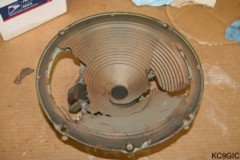
The cabinet proved to be a hefty task, partly due to my screwup! As before mentioned, the original finish was too far gone to salvage. If you look closely at the trim and bars on the speaker grille, it is covered with a paper type veneer, or photofinish. This finish is very tough to correctly reproduce, and luckily mine was in near perfect condition. With some warmer weather having arrived, it was time to do some refinish work outside. The first task was stripping the cabinet. Citri-Strip brand stripper was used during this process. Unfortunately an important thing was overlooked, masking off the parts that shouldn't be stripped, mainly the photofinish. While applying the stripper, a big glob was spilled, and ran down the front of the cabinet, instantly dissolving a few big stripes down the front of the photofinish. Below center: The damaged photofinish.
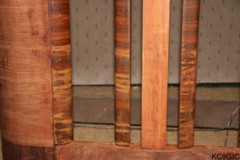
Upon the first power up, nothing happened. Testing voltages revealed that the rectifier tube was not working. Further inspection revealed that the 5Y3 tube had suffered an internal meltdown, with the plates all melted together. Oddly, nothing else on the radio was damaged. Replacing the tube had the radio working and sounding good. An alignment was carried out to peak the performance. Below center: The damaged speaker before repairs.

The cabinet proved to be a hefty task, partly due to my screwup! As before mentioned, the original finish was too far gone to salvage. If you look closely at the trim and bars on the speaker grille, it is covered with a paper type veneer, or photofinish. This finish is very tough to correctly reproduce, and luckily mine was in near perfect condition. With some warmer weather having arrived, it was time to do some refinish work outside. The first task was stripping the cabinet. Citri-Strip brand stripper was used during this process. Unfortunately an important thing was overlooked, masking off the parts that shouldn't be stripped, mainly the photofinish. While applying the stripper, a big glob was spilled, and ran down the front of the cabinet, instantly dissolving a few big stripes down the front of the photofinish. Below center: The damaged photofinish.

At
this point I was rather discouraged. Gravity was on my side with the
spill, and the run marks made in the photo finish were in the same
direction
as the grain, so touching up the bad spots would be within means. Using
Minwax stain sticks and some artistic skills, the runs were
blended in as best as possible. Sandpaper was also used to feather or
blend in the run marks with the undamaged areas. When applying the
toner lacquers,
the photofinish was blended in even more. The final lacquer sprayed on
consisted of several coats of thinned gloss lacquer. The grille cloth
was a reproduction purchased from RadioDaze.
Another tough job with the cabinet restoration was the application of new decals. Besides the "Westinghouse" logo located at the top center, there were decals under each knob designating the functions. Before stripping the cabinet, several photos were taken of the original decals so that they could be re-applied correctly. Decals were purchased from RadioDaze. After a tedious session of precision decal application, with the addition of some loud cursing, the radio was complete! Below photos: The Westinghouse in Fall 2009, shortly before being sold.
Another tough job with the cabinet restoration was the application of new decals. Besides the "Westinghouse" logo located at the top center, there were decals under each knob designating the functions. Before stripping the cabinet, several photos were taken of the original decals so that they could be re-applied correctly. Decals were purchased from RadioDaze. After a tedious session of precision decal application, with the addition of some loud cursing, the radio was complete! Below photos: The Westinghouse in Fall 2009, shortly before being sold.
